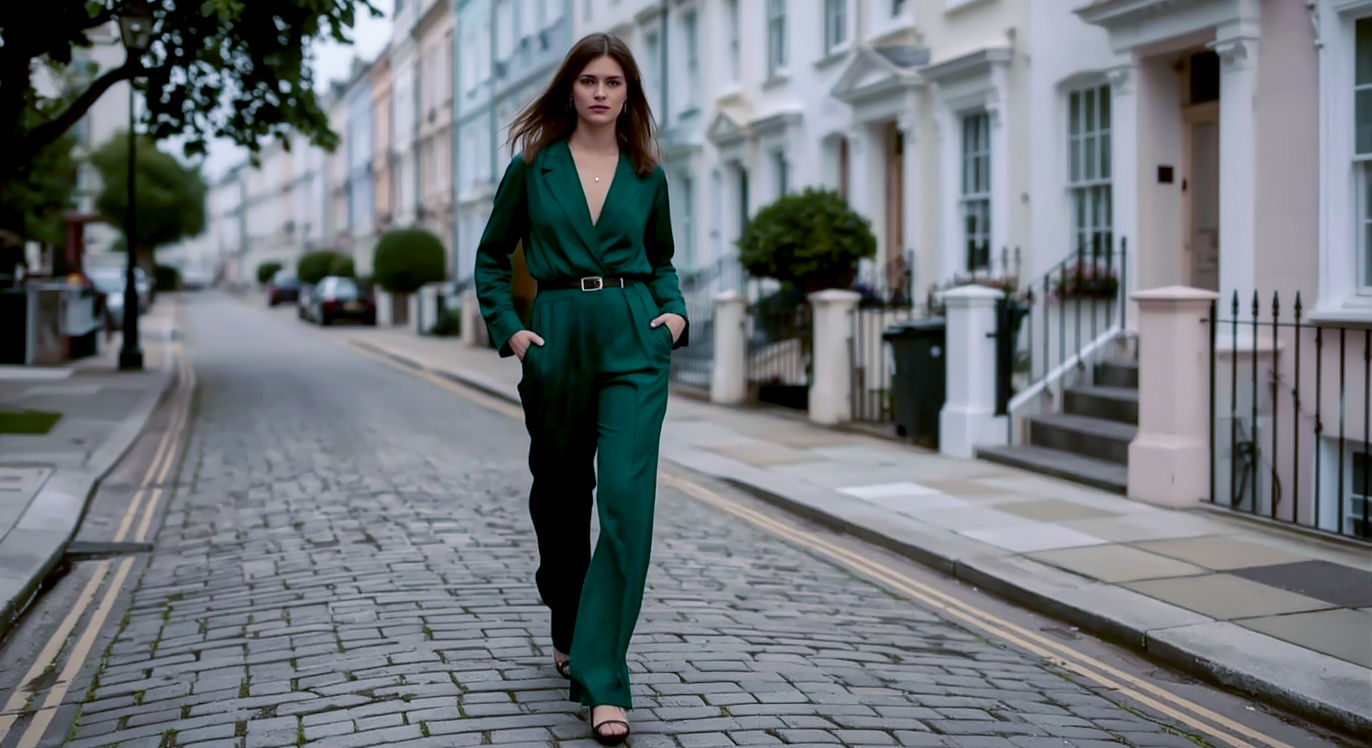Jumpsuits and Rompers: The One-Piece Outfits Guide
From workwear to weddings, discover why the jumpsuit is the ultimate wardrobe hero. Our complete UK guide helps you find the perfect style and fit.

This post may contain affiliate links. If you make a purchase through these links, we may earn a commission at no additional cost to you.
Ever stood in front of your wardrobe, wondering what on earth to wear? You want something stylish, but comfortable. Something that feels put-together, but without the faff of matching a top and trousers. Well, let me introduce you to your new best friend: the one-piece. We’re talking about jumpsuits and their shorter cousin, the romper.
For years, these all-in-one wonders have been quietly taking over the fashion world. You’ve probably seen them everywhere, from a Saturday stroll down the local high street to a glam night out in London. They’re the secret weapon in every stylish person’s wardrobe. Why? Because they’re incredibly simple. One item of clothing, and your whole outfit is sorted. It’s a bit like a full English breakfast in a single, perfect bite – all the best bits working together.
But jumpsuits and rompers are more than just an easy outfit. They have a fascinating history, starting as gear for parachutists and factory workers before becoming a symbol of rebellion and high fashion. They’ve been worn by everyone from David Bowie to the Duchess of Cambridge.
In this guide, we’re going to explore everything you need to know about these brilliant one-pieces. We’ll look at where they came from, how to find the perfect one for your shape, and how to style it for any occasion – whether it’s a rainy Tuesday in Manchester or a sunny wedding in the Cotswolds. So, let’s jump in and discover why the humble jumpsuit might just be the most versatile and stylish item you’ll ever own.
What’s the Difference, Anyway? Jumpsuit vs. Romper
Before we go any further, let’s clear up a common question. What’s the difference between a jumpsuit and a romper? It’s actually very simple and all comes down to the length of the bottoms.
- A jumpsuit is an all-in-one garment with full-length trousers. Think of it as a top and trousers joined together at the waist.
- A romper, sometimes called a playsuit in the UK, is the same idea but with shorts instead of long trousers.
So, a jumpsuit covers your full legs, while a romper or playsuit leaves them bare. That’s it! Because of this, you’ll often find yourself reaching for a romper in the summer months for a day at the beach or a picnic in the park. Jumpsuits, on the other hand, are brilliant all year round. You can wear a floaty linen one in summer or a thicker, tailored one in winter with a jacket.
Throughout this guide, we’ll talk about both, but many of the tips and tricks apply to both styles. After all, they’re part of the same stylish, one-piece family.
From Parachutes to Parties: A Surprisingly Rich History
You might think of the jumpsuit as a modern fashion statement, but its story begins over a century ago, and it has nothing to do with glamour. It started with practicality, worn by people doing some of the most daring and demanding jobs around.
The Birth of the ‘Boiler Suit’
The story really kicks off in the early 20th century. As factories and industries grew, workers needed tough, practical clothing. They needed something that wouldn’t get caught in machinery and would protect them from dirt and grease. The solution? The boiler suit. It was a simple, one-piece garment, usually made of heavy cotton or denim, that covered the whole body. It was easy to put on over your regular clothes and did its job perfectly. You can still see them today on mechanics and engineers.
Around the same time, another group of pioneers needed a similar solution: aviators. The first pilots flew in open cockpits, exposed to freezing winds. They needed warm, insulated one-pieces to survive. These ‘flight suits’ were the ancestors of the modern jumpsuit.
But the name ‘jumpsuit’ comes from a particularly brave group of people. In 1917, the Italian artist and designer Thayat created a one-piece garment he called the ‘Tuta’. It was meant to be a futuristic, practical piece of clothing for everyone. However, the name that stuck came from parachutists, who would literally ‘jump’ from planes in their protective one-piece suits.
From the Factory to High Fashion
For decades, the jumpsuit remained a practical item, worn by workers, pilots, and soldiers. It was seen as purely functional. But that all started to change in the 1930s, thanks to a daring fashion designer called Elsa Schiaparelli. She was known for her bold and unusual designs, and she saw the potential in the jumpsuit. She created a stylish, elegant one-piece for women, made from luxurious fabrics like silk. It was a shocking idea at the time – a woman wearing something so closely related to men’s workwear! But it planted a seed.
During the Second World War, the practical nature of the jumpsuit became important again. Women working in factories and on farms across Britain wore them as part of the war effort. The iconic poster of ‘Rosie the Riveter’ in the United States, with her blue work overalls, captured this spirit perfectly.
It wasn’t until the 1960s and ’70s that the jumpsuit truly exploded into the fashion world. This was a time of rebellion and breaking rules. The jumpsuit became a symbol of this new, modern spirit. It was unisex, worn by both men and women, which was a radical idea. Think of rock stars like Elvis Presley in his famous white, rhinestone-studded jumpsuits, or David Bowie as Ziggy Stardust in his colourful, futuristic creations. The jumpsuit was no longer just practical; it was cool, glamorous, and a little bit rebellious.
Designers like Yves Saint Laurent in Paris and Ossie Clark in London created incredibly chic and sophisticated jumpsuits for women. They were worn to glamorous parties and discos. The disco era of the 1970s was the jumpsuit’s golden age. Made from slinky, shiny fabrics, with wide-leg trousers, they were the perfect outfit for dancing the night away.
The Romper’s Playful Past
The romper, or playsuit, has a slightly different history. It started life as clothing for young children in the early 1900s. It was a comfortable, one-piece outfit with shorts that was easy for them to move and play in. It was seen as adorable and practical for little ones.
In the 1950s, the idea was adapted for women as casual summer wear. It was perfect for the beach or for lounging in the garden. It was seen as a fun, playful, and slightly daring piece of clothing. Like the jumpsuit, it became much more popular in the ’60s and ’70s, fitting in with the era’s love for freedom and fun.
The Modern Comeback
After the ’70s, the jumpsuit faded from the spotlight for a while. The 1980s were all about power shoulders and big hair, and the ’90s favoured a more minimalist, grunge look. But in the 2000s, the jumpsuit began to creep back into fashion.
Today, it’s a true wardrobe staple. Designers have reinvented it in countless ways, from casual denim styles to elegant, tailored versions perfect for a wedding. It’s no longer a niche or daring choice. It’s a chic, versatile, and modern option for women of all ages. From the factory floor to the fashion runway, the humble one-piece has had quite a journey.
Finding Your Perfect Fit: A Guide for Every Body Shape
One of the best things about jumpsuits and rompers is that there’s a style out there for everyone. The key is to find one that makes you feel comfortable and confident. It’s all about celebrating your shape and knowing what to look for. Let’s break it down.
Understanding Your Body Shape
Fashion experts often talk about a few common body shapes. You might fit into one of these, or you might be a combination. They’re just a helpful starting point!
- Pear Shape: Your hips are wider than your bust and shoulders. You often have a nicely defined waist.
- Apple Shape: You tend to carry weight around your middle and have a less defined waist. Your shoulders and hips are often narrower.
- Hourglass Shape: Your bust and hips are roughly the same width, with a clearly defined, narrower waist.
- Rectangle Shape (or Athletic): Your bust, waist, and hips are all a similar width, giving you a straighter silhouette.
- Inverted Triangle Shape: Your shoulders are broader than your hips.
Now, let’s find the perfect jumpsuit for you.
Jumpsuits for a Pear Shape
If you’re a pear shape, the goal is to balance your silhouette. You want to draw attention to your lovely defined waist and add a bit of volume to your top half.
- Look for: Jumpsuits with detail on the top. Think ruffles, statement sleeves, or an interesting neckline like a halter-neck or off-the-shoulder style. This will draw the eye upwards.
- Best necklines: A Bardot (off-the-shoulder) or a slash neck can help broaden your shoulders visually.
- Trouser shape: Go for a wide-leg or straight-leg style. This will skim over your hips and create a beautiful, flowing line. Avoid anything that clings too tightly to your hips and thighs.
- Cinch that waist: A belt or a jumpsuit with a built-in tie waist is your best friend. It will highlight your slimmest point.
Jumpsuits for an Apple Shape
For an apple shape, the aim is to create the illusion of a more defined waist and show off your great legs.
- Look for: Styles that flow loosely over your middle. A wrap-style jumpsuit can be fantastic, as it creates a V-neckline and cinches in just under the bust, which is often your narrowest point.
- Fabric is key: Avoid clingy fabrics. Look for materials that have a bit of structure or a nice drape, like a good quality jersey or crepe.
- Neckline: A V-neck or a scoop neck is great for elongating your torso.
- Leg shape: A straight-leg or a slim-leg jumpsuit will look amazing on you and highlight your legs. If you’re wearing a romper, you can go for a shorter length to really show them off.
Jumpsuits for an Hourglass Shape
If you have an hourglass figure, you want to celebrate your curves and your defined waist.
- Look for: Jumpsuits that follow your natural silhouette. Fitted styles that cinch in at the waist are perfect for you.
- Waist definition: A belt is a must! It will draw attention to your waist and keep your proportions balanced.
- Neckline: A sweetheart neckline, a scoop neck, or a V-neck will all look fantastic.
- Leg shape: You can pull off almost any leg shape, from a skinny fit to a dramatic wide leg. A wide-leg or flared jumpsuit will beautifully balance your hips.
Jumpsuits for a Rectangle Shape
For a rectangle or athletic shape, you can use a jumpsuit to create the illusion of more curves.
- Look for: Styles that add volume to both your bust and your hips. Think jumpsuits with ruffles or details on the top, and trousers that are a bit wider, like a culotte or a wide-leg style.
- Create a waist: This is the most important trick. A belt is essential. You can also look for jumpsuits with a contrasting top and bottom, or a peplum detail at the waist, to create the illusion of a curvier shape.
- Neckline: A scoop neck or a halter neck can add softness.
- Details are everything: Look for pockets on the hips, ruching, or pleats to add interest and shape.
Jumpsuits for an Inverted Triangle Shape
If you have broader shoulders, the goal is to add a little volume to your lower half to create a more balanced silhouette.
- Look for: Simple, clean lines on top. Avoid big puffy sleeves or lots of ruffles on the shoulders. A simple V-neck or scoop neck is perfect.
- Draw attention downwards: This is your secret weapon. Look for jumpsuits with wide-leg, flared, or culotte-style trousers. Prints or brighter colours on the bottom half can also work wonders.
- Neckline: A halter neck can be surprisingly flattering, as it draws the eye inwards and away from the width of your shoulders.
- Waist: A belt will help to create a more defined waistline.
A Few Universal Tips
- Torso length is crucial: The biggest problem people have with jumpsuits is finding one that fits their torso. If it’s too short, it will be very uncomfortable! If it’s too long, it will look baggy. If you have a particularly long or short torso, look for brands that offer ‘tall’ or ‘petite’ ranges.
- Try before you buy: If you can, always try a jumpsuit on. Walk around, sit down. Make sure it feels comfortable.
- Don’t be afraid of a tailor: A few small alterations can make a good jumpsuit look like it was made for you. Getting the length of the trousers just right makes a huge difference.
How to Style Your Jumpsuit: From Casual Coffee to a Chic Wedding
The true magic of a jumpsuit is its versatility. With a few simple styling tricks, you can take the same jumpsuit from a relaxed weekend outing to a formal event. It’s all about the accessories and layers you choose.
The Casual Daytime Look
This is the jumpsuit in its natural habitat. Perfect for running errands, meeting friends for a coffee, or a trip to the local market.
- The Jumpsuit: A denim boiler suit, a soft cotton or jersey jumpsuit, or a linen one in summer are all fantastic choices. Think comfort and practicality.
- Footwear: Keep it simple and comfortable. White trainers are a classic choice that always looks fresh. Flat sandals or espadrilles are perfect for warmer days. In autumn, a pair of Chelsea boots or chunky loafers works brilliantly.
- Outerwear: A denim jacket thrown over a cotton jumpsuit is a timeless look. A casual leather jacket can add a bit of edge. For a softer look, try a long, chunky cardigan.
- Accessories: A simple crossbody bag or a tote bag is perfect for carrying your essentials. Keep jewellery minimal – maybe some simple hoop earrings or a delicate necklace. A pair of sunglasses completes the look.
The Smart Office Look
Yes, you can absolutely wear a jumpsuit to the office! The key is to choose a style that is smart, tailored, and professional.
- The Jumpsuit: Look for a well-cut, tailored style in a solid, neutral colour like black, navy, charcoal grey, or khaki. A wide-leg or straight-leg silhouette is usually best for a professional setting. Avoid anything too low-cut, backless, or made from very casual fabrics like jersey. A culotte jumpsuit can also be a very chic option.
- Footwear: A classic court shoe, a smart loafer, or a pointed-toe flat will all look polished. A block heel is a comfortable yet smart choice.
- Outerwear: A structured blazer is the perfect partner for a jumpsuit in the office. It instantly adds a layer of professionalism. Choose a blazer in a contrasting colour to add interest, or a matching one for a sleek, suit-like effect.
- Accessories: A structured work bag is essential. Keep jewellery elegant and understated. A simple watch and some stud earrings are all you need. A belt can also help to make your jumpsuit look more formal and put-together.
The Evening Out Look
Whether you’re going out for dinner, to the theatre, or for cocktails with friends, a jumpsuit can be an incredibly chic and modern alternative to a dress.
- The Jumpsuit: This is where you can have some fun! Look for jumpsuits in luxurious fabrics like silk, satin, or velvet. A well-made crepe jumpsuit can also look incredibly elegant. Details like a halter neck, an asymmetric shoulder, or a backless design can add drama. Black is always a classic and sophisticated choice, but don’t be afraid of bold colours like red, emerald green, or cobalt blue.
- Footwear: Heels are your friend here. A pair of strappy heeled sandals or elegant pointed-toe stilettos will elongate your legs and instantly elevate the look.
- Outerwear: A smart tuxedo-style blazer, a faux fur coat in winter, or a chic cropped jacket will complete your evening look. You could even wear a beautiful pashmina or wrap.
- Accessories: This is your chance to shine. A statement clutch bag, some sparkling earrings, or a bold necklace can transform your jumpsuit. A touch of red lipstick adds instant glamour.
The Wedding Guest Look
A jumpsuit is a fantastic, modern, and comfortable choice for a wedding guest. You’ll stand out from the sea of dresses for all the right reasons.
- The Jumpsuit: Choose a style that is elegant and celebratory. Soft pastels, beautiful floral prints, or vibrant jewel tones are all great options. Look for floaty, wide-leg styles in fabrics like chiffon or crepe that move beautifully. Avoid white or anything too casual, like denim or jersey.
- Footwear: Heeled sandals or elegant court shoes are perfect. If the wedding is on grass, a block heel or a wedge is a much more practical choice than a stiletto!
- Outerwear: A smart blazer, a chic pashmina, or a tailored coat that matches the formality of the event is ideal.
- Accessories: A fascinator or a stylish hat can look wonderful with a jumpsuit and is perfectly appropriate for a British wedding. Pair it with an elegant clutch bag and some delicate jewellery.
Styling a Romper or Playsuit
A romper is your ultimate summer companion. It’s perfect for holidays, festivals, and sunny days at home.
- The Casual Look: Pair a simple cotton or linen romper with flat sandals, a straw bag, and sunglasses for an effortless holiday look.
- Dressed up: You can dress a romper up for a summer evening. Choose one in a slightly more elevated fabric, and pair it with wedge espadrilles and some gold jewellery. A light denim jacket is perfect for when the sun goes down.
- Festival Fun: A printed romper with a pair of wellies or chunky boots, a crossbody bag, and a rain mac is a classic festival outfit.
The key to styling any one-piece is to treat it like a blank canvas. By changing your shoes, jacket, and accessories, you can create a completely different look every time.
The Fabric Guide: Choosing the Right Material for Comfort and Style
The fabric of your jumpsuit or romper makes a huge difference to how it looks, feels, and where you can wear it. A denim boiler suit has a completely different vibe to a silk evening jumpsuit. Understanding a few key fabrics will help you make the best choice.
Natural Fibres: The Breathable Champions
These fabrics come from plants or animals and are known for being comfortable and breathable.
- Cotton: This is one of the most common and versatile fabrics. It’s soft, breathable, and easy to care for. A cotton jumpsuit is perfect for casual, everyday wear. It’s comfortable in both warm and cool weather. Look for cotton jersey for a soft, stretchy, T-shirt-like feel, or a structured cotton twill for a smarter look.
- Linen: This is the ultimate summer fabric. Made from the flax plant, it’s incredibly lightweight and breathable, making it perfect for hot weather. It has a lovely, slightly textured look. The only downside is that it creases easily, but many people feel that’s part of its relaxed charm. A linen jumpsuit is a holiday essential.
- Denim: Strong, durable, and effortlessly cool. A denim jumpsuit or boiler suit is a timeless classic. It’s perfect for a casual, utilitarian look. It can be a bit heavy for very hot days, but it’s great for spring, autumn, and cooler summer days in the UK.
- Silk: The queen of luxury fabrics. Silk is incredibly soft, smooth, and has a beautiful, subtle sheen. It drapes beautifully over the body. A silk jumpsuit is a stunning choice for a formal event or a special evening out. It’s delicate and usually needs to be dry-cleaned.
- Wool: You might not immediately think of wool for a jumpsuit, but a tailored jumpsuit in a lightweight wool crepe can be an incredibly chic and smart option for the office or for an autumn or winter event. It’s warm, drapes well, and is naturally crease-resistant.
Man-Made Fibres: The Practical Performers
These fabrics are created through chemical processes and often offer practical benefits like durability and crease resistance.
- Viscose (or Rayon): This is a semi-synthetic fabric made from wood pulp. It’s designed to feel like natural fibres like silk or cotton. It’s soft, breathable, and drapes beautifully, making it a popular choice for floaty, wide-leg jumpsuits and printed rompers. It can be a bit more delicate than cotton, so check the care label.
- Polyester: This is a very common and affordable synthetic fabric. Modern polyester can be very impressive – it’s durable, crease-resistant, and holds its colour well. It’s often used for smarter jumpsuits, especially in a crepe weave, which gives it a lovely textured, matte finish that looks very expensive. It’s not as breathable as natural fibres, so it might not be the best choice for a very hot day.
- Tencel (or Lyocell): This is a modern, eco-friendly fabric made from sustainably sourced wood pulp. It’s a dream to wear – it’s incredibly soft (often compared to silk), breathable, and drapes beautifully. It’s also very durable and less prone to creasing than viscose. You’ll often find it used for casual, relaxed-fit jumpsuits.
- Velvet: Usually made from polyester or a blend, velvet is a luxurious, plush fabric with a deep pile. It’s perfect for an evening or party jumpsuit, especially in winter. It has a rich, glamorous feel that’s perfect for festive occasions.
When you’re choosing a jumpsuit, think about where you’re going to wear it. For a hot summer holiday, linen or cotton is best. For a smart work event, a polyester crepe or a wool blend will look sharp all day. And for pure, everyday comfort, you can’t beat a soft cotton jersey or Tencel.
The Future of the One-Piece
The jumpsuit has proven it’s not just a passing trend. It’s a permanent fixture in the modern wardrobe. So, what’s next for this versatile garment?
We’re likely to see a continued focus on sustainability. Brands are increasingly using eco-friendly fabrics like organic cotton, linen, and Tencel. We’ll also see more jumpsuits designed for longevity – timeless, well-made pieces that you can wear for years, rather than fast-fashion items.
Versatility will remain key. We’ll see more clever designs that can be dressed up or down easily, taking you from day to night. Think jumpsuits with removable belts, adjustable sleeves, or smart fabrics that are comfortable enough for lounging but chic enough for a meeting.
We may also see a return to the jumpsuit’s utilitarian roots. The ‘boiler suit’ look remains popular, with its focus on comfort, practicality, and a cool, androgynous edge. Expect to see more jumpsuits with practical details like big pockets and sturdy zips.
The romper or playsuit will continue to be a summer favourite, but we might see more ‘skorts’ styles – a clever combination of shorts and a skirt overlay, offering the look of a mini dress with the practicality of a romper.
Ultimately, the enduring appeal of the jumpsuit and romper lies in its simplicity and confidence. In a busy world, the ease of a one-piece outfit is a small luxury. It’s a single garment that makes a complete statement. It says you’re confident, you’re stylish, and you’re ready for anything. And that’s a trend that will never go out of style.
Further Reading
To continue your exploration of fashion history and styling, here are some highly respected resources:
- Vogue UK: https://www.vogue.co.uk/ – For the latest runway trends, fashion news, and styling inspiration.
- The Victoria and Albert Museum (V&A): https://www.vam.ac.uk/ – Explore their extensive online fashion collection and articles on the history of dress.
- The Business of Fashion: https://www.businessoffashion.com/ – For in-depth analysis of the fashion industry and its evolution.
- Who What Wear UK: https://www.whowhatwear.co.uk/ – A great resource for accessible, trend-led styling advice and shopping guides.






